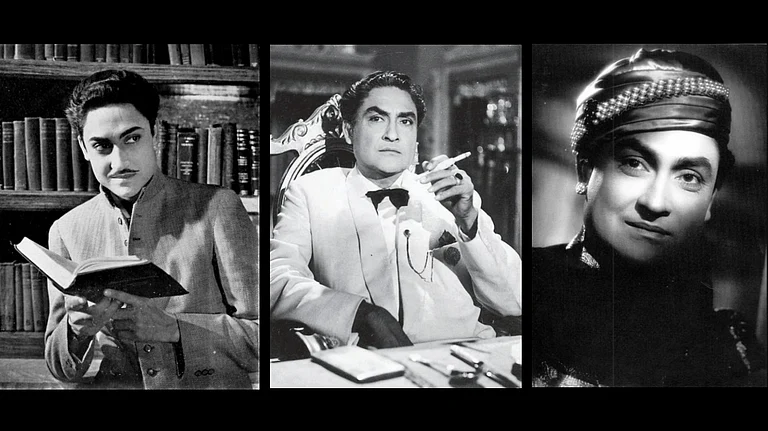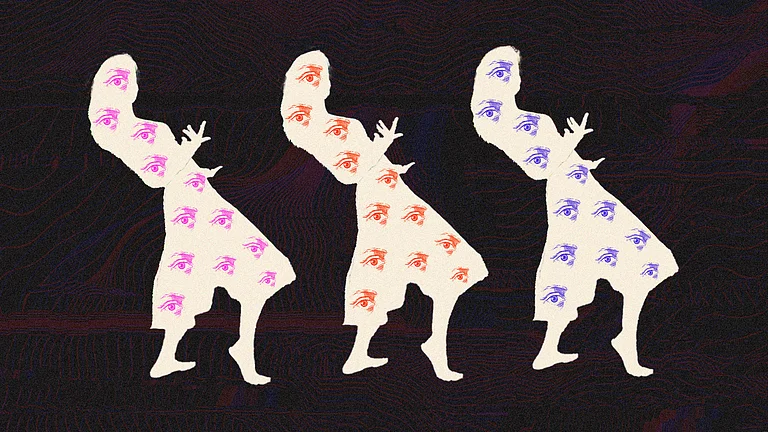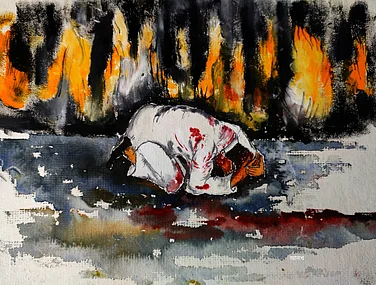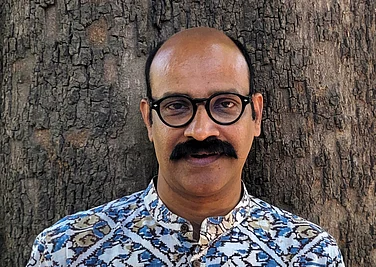Is there a Punjabi who does not want to forget the name of Indira Billi? It is such a regretful accident that a woman of cat-like height represented the quintessential Punjaban in films for a decade-and-a-half. Almost all who have seen Mumtaz Shanti in Mangti (1942); Manorma in Gowandhi (1942), Mera Mahi (1941) and Patwari (1942); Ragni in Dulla Bhatti (1940) and Sehti Murad (1941) have perished. Those who have seen Nishi in Pind Di Kudi (1963), Indira Billi in Mama Ji (1964), and Parveen Chaudhary in Shaunkan Mele Di (1965) will die in another 30 to 40 years. But those who have seen and liked Vimi in Nanak Nam Jahaz Hai (1969) and Meena Rai in Mittar Pyare Nu (1975) — did they ever live? I doubt. If my doubt is wrong, no one has the right to doubt the claim that Rabindranath Tagore was a famous Punjabi or Mohammed Ali was a wrestler born in the village Aasal Bhoora of Punjab’s Majha region.
The myth about Punjabis being daft and enemies of serious engagement is so pervasive that even the Punjabis subscribe to it. This is why Boota Singh Shad made such a shallow film adaptation Kulli Yaar Di (1969) of his profound novel Adhi Raat Pehar Da Tadka (Midnight and Early Morning). This is the reason Gulzar makes Aandhi (1975) and Mausam (1975), Rajendra Singh Bedi makes Chetna (1970, dir. BR Ishara), Dastak (1970), Phagun (1973) and Raj Kapoor makes films like Mera Naam Joker (1970) in Hindi. This is why the house goes over full in Delhi’s Sapru House for plays like Charhi Jawani Buddhe Nu (The Old Man is Feeling Young). This is why when the Prime Minister arrives wearing a salwar kameez there is a wave of pride and joy in Kamagata Maru Nagar (village Mataur, Mohali). This is why Ajaib Kamal’s Wartman Turia Hai (The present has started) is considered Punjabi poetry.
The first Punjabi-speaking film Alam Ara (1931) was not Punjabi in its name or theme. [Note: Alam Ara was India’s first talkie in Hindi-Urdu language. It was not a Punjabi film.]. Now Mera Punjab (1940), Ravi Paar (1942), Satluj De Kandey (1964), Jagga (1964), and Main Jatti Punjab Di (1964) are not Punjabi even though their names and themes are Punjabi. Punjabi cinema was born in the times when theatres were prepared with tents. When singers like Kundan Lal Sehgal, musicians like Ghulam Haidar, directors like Roop K Shauri, and story-dialogue-lyrics writers like Baldev Chandra Bekal were part of the Punjabi film industry. Now, when there are state-of-the-art theatres like ‘Narendra’ and ‘Friends’ (in Jalandhar), and we have viewers from the last decades of the twentieth century. Now, when singers like Mohammed Rafi, Mahinder Kapoor, Narinder Chanchal, and Shamshad Begum have established themselves in the Punjabi film industry. Writers like Boota Singh Shad and lyricists like Babu Singh Mann and Kashmir Kadar have entered the fray. But the level of Punjabi films has declined instead of going up.

Mangti ran in Lahore for a full year. After the partition, Nanak Nam Jahaz Hai could not even run for a few months, although it was a purely religious film. Only a fool can state its reason to be a lack of ‘aesthetics and sensibility of the viewers.’ Balraj Sahni served the Punjabi films by working pro bono in Pavitar Papi (1970) [it was actually a Hindi language film]. The Punjab government served Punjabi films by giving tax rebates to those with religious-sounding names. The Kapoor family served the Punjabi films by not meddling in them. Unfortunately, the Punjabi film industry has gotten many volunteers willing to serve but no sensible artists.
We felt respite that Punjabi cinema no longer has to carry the weight of ghaggras, lehngas, caricaturish dances, heroes like sons of the rich, and heaps of hay. But in its place, it has to carry the weight of nihangs, priests, temples, nonsensical supernatural plots, and collegiate bhangra performances. It is still a blessing that chauvinistic detective tales of pseudo-patriotism and rural legends have not taken root. But you never know for how long can we be immune to these diseases.
You must have seen at least one of the films, Chambe Di Kali (1965), Bhagat Dhanna Jatt (1974), Nanak Dukhia Sab Sansaar (1970), Taakra (1976) or Daaj (1976). If you have not seen any, you must have read a novel by Sir Joginder Singh, Bhai Vir Singh or Nanak Singh. If you have not done any of these two, you can be proud of your fate.
You know it well. In these films, either the boys or girls from Punjab are uneducated. One among them comes to the village in a tonga or a train after finishing college. Before reaching home they coincidentally meet a beauty or a hunk. A minor altercation between them is not out of the ordinary either. Our character will keep his stuff at home and why would not the person now go for a stroll in the fields, where songs exalting the country’s crops, wells, buffaloes, beauty or historic greatness are in the air already? Anything can happen after this. Usually, a formidable adversary in the form of a local thug (who will never be a feudal lord or a corrupt official), with whom the conflict can start before or after the love affair with the beauty/hunk (the timing does not matter much). Fight sequences and dancing to love songs follow. In the end, goodness and love aren’t going to be defeated; the evil has to lose of course. Or it can also happen that we see a true bhakt of the Lord, carrying on his noble path with devotion. Bhakts are not an endangered species on this planet. The conflict is either natural or man-made — a miracle will resolve it in moments. In this drama, a young and beautiful couple’s love triumphs over all the problems and comes to its conclusion. This is what happens or can happen in Punjab.
Anyhow, it is not any good to whine about these problems when they are not specific to the Punjabi film industry but are there in the whole Hindi film industry as well. Film journalists in Hindi media have been critiquing or applauding these trends for a long time. But despite the eclipsing influence of the Hindi film industry, there have been good films in Bengali and Malayalam languages; and viewers in these states are not more sophisticated and advanced than the Punjabis.
No one in the Punjabi film industry has the right to complain that good films flop. Because no one has ever tried making one. It would be unfair to blame Punjabi people for the fate that some experiments in Hindi have met. The reasons for the failure of some good Hindi films (in Punjab) are geographic in particular and political in general. These reasons cannot be imposed on films of regional languages in the same vein.
The leaders of religion and the nation do not want to understand the fact that profiteering is an enemy of both spirituality and patriotism in its essence. If there is profiteering, then other two things can’t be there. If they are there and it is the profiteers who are making films on these subjects, then they will trivialise and sabotage these subjects for sure. They will corrupt these subjects for their own interests. If there are films like Haqeeqat (1964) and Upkaar (1967), then the central government makes them tax-free. If there is Nanak Nam Jahaz Hai, then the Sikhs remove their shoes before entering the theatres.
The spectre of profiteering can use any ism, politics, religion, law, literature and art to capture its prey. The voluntary service intent of people like Balraj Sahni will be a fly on the wall. People will keep entering and leaving the cage of the theatre with claps, whistles and tears. People have had these in abundance since the beginning of the time and it will always be so.
It has been a while since Amrita Pritam began thinking about making a Punjabi film based on her novel Pinjar. However, she has not received the necessary support from the Film Corporation. There are many Punjabi theatre actors in Bombay who are closely connected to both literature and acting. The talented Jaswant Kaur ‘Daman’ from the Norah Richards Theatre has made it to the film screen, while Jagjeet Chuharchak has been playing small Punjabi roles for quite some time. Even the Punjab government has started to think seriously about Punjabi films. These are signs of broadening horizons. However, neither the donkeys nor the monkeys are lazing around; they are ready to act before the merchant does.
Recently, Boota Singh made Dharti Sadi Ma (1976), tomorrow the land will become our aunt. But I wish! It becomes a place for the humans to live.
Translated from Punjabi by Jasdeep Singh.
Note: Going by the films and events he has cited, Pash might have written the essay between 1976 and ’77. According to lyricist Shamsher Sandhu, it was published in the magazine Sankalp, edited by Sandhu and others. But the last issue of Sankalp was published in June 1975. The essay is also published in a book of Pash’s writings titled ‘Pash: Sampooran Likhtan’ edited by Amolak Singh, Tarkbharati Parkshan, Barnala, September 2019























